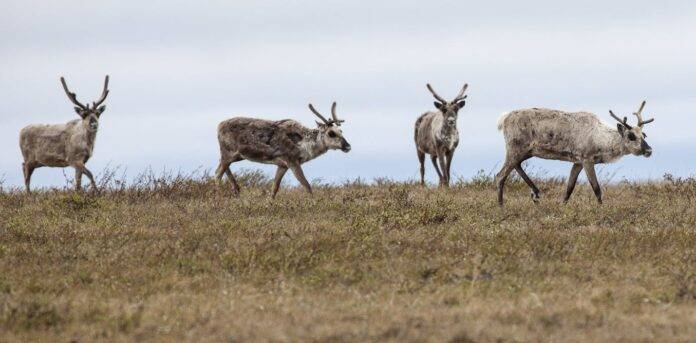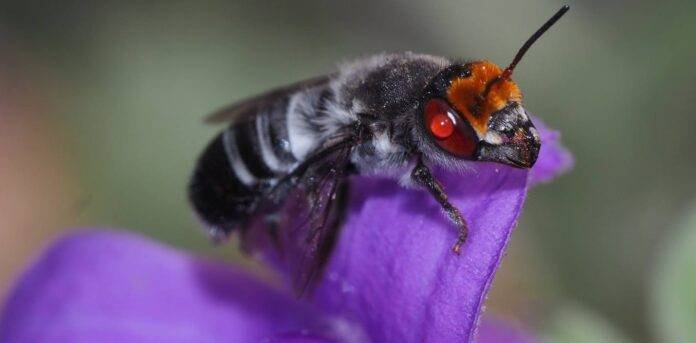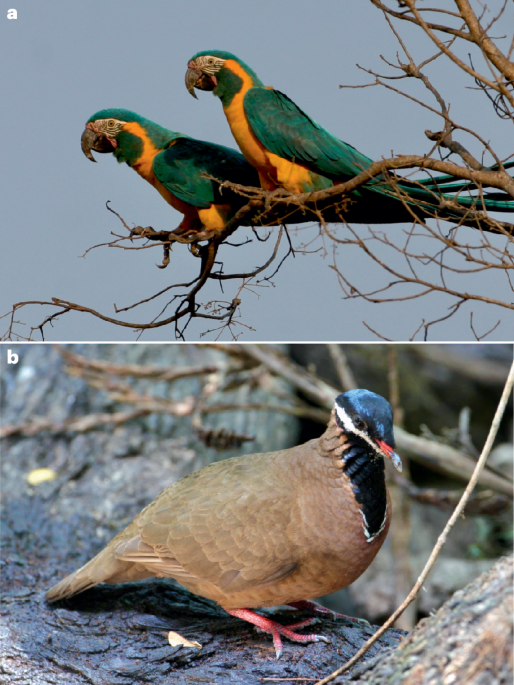Gatti, R. C. et al. The number of tree species on Earth. Proc. Natl. Acad. Sci. USA. 119, e2115329119 (2022).
Simon, M. F. et al. Recent assembly of the cerrado, a neotropical plant diversity hotspot, by in situ evolution of adaptations to fire. Proc. Natl. Acad. Sci. USA. 106, 20359–20364 (2009).
Brummitt, N., Araújo, A. C. & Harris, T. Areas of plant diversity—What do we know? Plants People Planet 3, 33–44 (2021).
Ratter, J. A., Richards, A. P., Argent, W. & Gifford, D. R. Observations on the vegetation of northeastern Mato Grosso: I. The woody vegetation types of the Xavantina-Cachimbo Expedition area. Philos. Trans. R. Soc. Lond. B Biol. Sci. 266, 449–492 (1973).
Marimon, B. S., Lima, E. S., Duarte, T. G., Chieregatto, L. C. & Ratter, J. A. Studies in monodominant forests in eastern Mato Grosso, Brazil: I. A forest of Brosimum rubescens Taub. Edinb. J. Bot. 63, 323–341 (2006).
Vourlitis, G. L. et al. Tree growth responses to climate variation in upland and seasonally flooded forests and woodlands of the Cerrado-Pantanal transition of Brazil. Ecol. Manag. 505, 119917 (2022).
Marques, E. Q. et al. Redefining the Cerrado–Amazonia transition: implications for conservation. Biodivers. Conserv. 29, 1501–1517 (2020).
Bispo, P. C. et al. Overlooking vegetation loss outside forests imperils the Brazilian Cerrado and other non-forest biomes. Nat. Ecol. Evol. 8, 12–13 (2024).
Françoso, R. D. et al. Habitat loss and the effectiveness of protected areas in the Cerrado Biodiversity Hotspot. Nat. Conserv. 13, 35–40 (2015).
Myers, N., Mittermeier, R. A., Mittermeier, C. G., Fonseca, G. A. B. & Kent, J. Biodiversity hotspots for conservation priorities. Nature 403, 853–858 (2000).
Oliveira-Filho, A. T. & Ratter, J. A. Vegetation physiognomies and woody flora of the Cerrado biome in The Cerrados of the Brazil: Ecology and Natural History of a Neotropical Savanna (Columbia University Pres, 2002), pp. 91–120 https://doi.org/10.7312/oliv12042-007.
Hortal, J. et al. Seven shortfalls that beset large-scale knowledge of biodiversity. Annu. Rev. Ecol. Evol. Syst. 46, 523–549 (2015).
Guilherme, F. A. G., Junior, A. F., Pereira, F. C., Silva, G. E. & Maciel, E. A. Disturbances and environmental gradients influence the dynamics of individuals and basal area in the Cerrado complex. Trees. People 9, e100298 (2022).
Strassburg, B. B. et al. Moment of truth for the Cerrado hotspot. Nature Nat. Ecol. Evol 1, 1–3 (2017).
Hofmann, G. S. et al. The Brazilian Cerrado is becoming hotter and drier. Global Glob. Change Biol. 27, 4060–4073 (2021).
ter Steege, H. et al. Hyperdominance in the Amazonian tree flora. Science 342, e1243092 (2013).
ter Steege, H. et al. Biased-corrected richness estimates for the Amazonian tree flora. Sci. Rep. 10, e10130 (2020).
Nobre, C. A. & Borma, L. D. S. Tipping points’ for the Amazon forest. Curr. Opin. Environ. Sustain. 1, 28–36 (2009).
Passos, F. B. et al. Savanna turning into forest: concerted vegetation change at the ecotone between the Amazon and “Cerrado” biomes. Braz. J. Bot. 41, 611–619 (2018).
Ratter, J. A., Ribeiro, J. F. & Bridgewater, S. The Brazilian cerrado vegetation and threats to its biodiversity. Ann. Bot. 80, 223–230 (1997).
Durigan, G. Zero-fire: Not possible nor desirable in the Cerrado of Brazil. Flora 268, e151612 (2020).
Watson, J. E. et al. The exceptional value of intact forest ecosystems. Nat. Ecol. Evol. 2, 599–610 (2018).
Matricardi, E. A. T. et al. Long-term forest degradation surpasses deforestation in the Brazilian Amazon. Science 369, 1378–1382 (2020).
Rajão, R. et al. The rotten apples of Brazil’s agribusiness. Science 369, 246–248 (2020).
Ribeiro, J. F. & Walter, B. M. T. As principais fitofisionomias do bioma Cerrado in Cerrado ecologia e flora. (EMBRAPA, 2008) pp. 151–212
Françoso, R. D. et al. Delimiting floristic biogeographic districts in the Cerrado and assessing their conservation status. Biodiversity and Conservation. Biodivers. Conserv. 29, 1477–1500 (2020).
MMA (Ministério do Meio Ambiente e Mudanças do Clima, Brasil) Mapa de Cobertura Vegetal https://antigo.mma.gov.br/biomas/cerrado/mapa-de-cobertura-vegetal.html (2024).
Borghetti, F. et al. Fitogeografia das savanas sul-americanas. Heringeriana 17, e918014 (2023).
Alvares, C. A., Stape, J. L., Sentelhas, P. C., Gonçalves, J. D. M. & Sparovek, G. Stem protective tissue in Erythroxylum tortuosum (Erythroxylaceae), a fire tolerant species from cerrado. Meteorol. Z. 22, 711–728 (2013).
Reatto, A., Correia, J. R., Spera, S. T., Martins, E. S. Solos do bioma Cerrado: aspectos pedológicos in Cerrado: ecologia e flora. (EMBRAPA, 2008), pp. 107–149.
Marimon-Junior, B. H. et al. Soil water-holding capacity and monodominance in Southern Amazon tropical forests. Plant Soil. 450, 65–79 (2019).
Felfili, J. M., Carvalho, F. A., Haidar, R. F. Eds. Manual para o monitoramento de parcelas permanentes nos biomas Cerrado e Pantanal (Editora UnB, 2005).
Alvarez, F. et al. Climate defined but not soil-restricted: the distribution of a Neotropical tree through space and time. Plant Soil. 471, 175–191 (2022).
ter Steege, H. et al. Estimating the global conservation status of more than 15,000 Amazonian tree species. Sci. Adv. 1, e1500936 (2015).
Silva, S. T. Aspectos morfológicos e fisio-ecológicos da absorção de ácido silícico em Curatella Americana (Dilleniaceae), Thesis, USP, São Paulo, SP (1983).
Walter, B. M. T. et al. Fitofisionomias do Cerrado: classificação, métodos e amostragens fitossociológicas in Fitossociologia no Brasil: métodos e estudos de casos (Editora UFV Press), pp. 83–212. (2015).
Ratter, J. A., Bridgewater, S. & Ribeiro, J. F. Analysis of the floristic composition of the Brazilian cerrado vegetation III: Comparison of the woody vegetation of 376 areas. Edinb. J. Bot. 60, 57–109 (2003).
Bridgewater, S., Ratter, J. A. & Ribeiro, J. F. Biogeographic patterns, β-diversity and dominance in the Cerrado biome of Brazil. Biodivers. Conserv. 13, 2295–2318 (2004).
Morandi, P. S. et al. Tree diversity and above-ground biomass in the South America Cerrado biome and their conservation implications. Biodivers. Conserv. 29, 1519–1536 (2020).
Françoso, R. D., Haidar, R. F. & Machado, R. B. Tree species of South America central savanna: endemism, marginal areas and the relationship with other biomes. Acta Bot. Bras. 30, 78–86 (2016).
Hubbell, S. P. The unified neutral theory of biodiversity and biogeography (Princeton University Press, ed. 32, 2001). https://doi.org/10.1515/9781400837526.
Levis, C. et al. How people domesticated Amazonian forests. Front. Ecol. Evol. 5, e171 (2018).
Iriarte, J. et al. The origins of Amazonian landscapes: Plant cultivation, domestication and the spread of food production in tropical South America. Quat. Sci. Rev. 248, e106582 (2020).
Coelho, S. D. et al. Eighty-four per cent of all Amazonian arboreal plant individuals are useful to humans. PLoS One 16, e0257875 (2021).
Elias, F., Marimon-Junior, B. H., de Oliveira, F. J. M., de Oliveira, J. C. A. & Marimon, B. S. Soil and topographic variation as a key factor driving the distribution of tree flora in the Amazonia/Cerrado transition. Acta Oecol. 100, e103467 (2019).
Marimon, B. S., Felfili, J. M. & Haridasan, M. Studies in monodominant forests in eastern Mato Grosso, Brazil: I. A forest of Brosimum rubescens Taub. Edinb. J. Bot. 58, 123–137 (2001).
Hoffmann, W. A. et al. Ecological thresholds at the savanna-forest boundary: how plant traits, resources and fire govern the distribution of tropical biomes. Ecol. Lett. 15, 759–768 (2012).
Oliveira, M. D. et al. Avaliação da inflamabilidade de espécies nativas do cerrado. Biotemas 33, e74323 (2020).
Mistry, J. et al. Indigenous Fire Management in the cerrado of Brazil: The Case of the Kraho of Tocantins. Hum. Ecol. 33, 365–386 (2005).
Feldpausch, T. R. et al. Forest Fire History in Amazonia Inferred from Intensive Soil Charcoal Sampling and Radiocarbon Dating. Front. Glob. Change 5, e815438 (2022).
Coutinho, L. M. Fire in the ecology of the Brazilian cerrado. In Fire in the tropical biota (Springer, 1990), pp. 82–105. https://doi.org/10.1080/00222930310001647343.
Haridasan, M. Nutritional adaptations of native plants of the cerrado biome in acid soils. Braz. J. Plant Physiol. 20, 183–195 (2008).
Andrade, L. M. R. et al. Al-hyperaccumulator Vochysiaceae from the Brazilian Cerrado store aluminum in their chloroplasts without apparent damage. Environ. Exp. Bot. 70, 37–42 (2011).
Doyle, J. J. & Luckow, M. A. The rest of the iceberg. Legume diversity and evolution in a phylogenetic context. Plant Physiol. 131, 900–910 (2003).
INPE/PRODES (Instituto de Pesquisas Espaciais, Brasil) Plataforma de dados geográficos. https://terrabrasilis.dpi.inpe.br/app/dashboard/deforestation/biomes/amazon/increments (2024).






